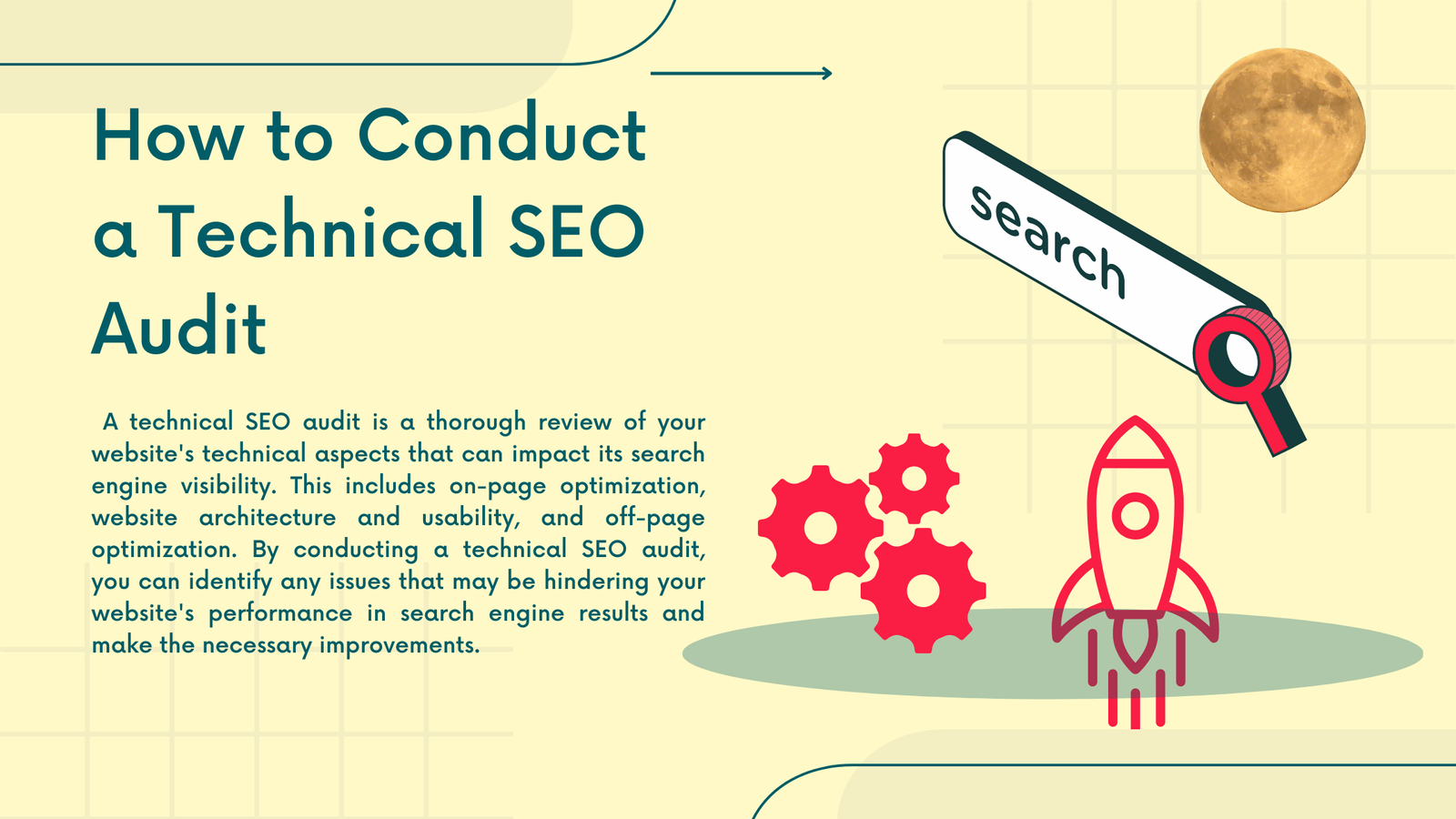
A Complete Guide to Payment Methods for Nigerian E-Commerce Businesses
December 15, 2022
Why Keyword Research is Essential for SEO Success
January 8, 2023Blog Outline:
- Introduction
- Definition of technical SEO
- Importance of conducting a technical SEO audit
- Preparation
- Gathering necessary tools and resources
- Identifying goals and objectives of the audit
- Setting up a schedule and timeline for the audit
- On-page optimization
- Checking for proper use of header tags and titles
- Evaluating the use of meta descriptions and tags
- Analyzing website content for relevance and quality
- Examining the use of alt tags for images
- Reviewing the website’s internal linking structure
- Website architecture and usability
- Evaluating the website’s navigation and structure
- Checking for broken links and error pages
- Testing the website’s mobile responsiveness and usability
- Analyzing the website’s loading speed and performance
- Off-page optimization
- Examining the website’s backlink profile
- Analyzing the website’s presence on social media platforms
- Evaluating the website’s local SEO efforts
- Checking for proper use of schema markup and structured data
- Monitoring and tracking
- Setting up tracking and monitoring tools
- Identifying key performance indicators (KPIs) to track
- Establishing a process for regularly reviewing and analyzing data
- Conclusion
- Summary of findings and recommendations
- Importance of regularly conducting technical SEO audits
- Next steps for implementing improvements and optimizations based on audit results

Introduction
If you’re running a website, you know the importance of search engine optimization (SEO). SEO is the process of optimizing your website to rank higher in search engine results pages, making it more visible to potential customers. But how do you know if your SEO efforts are actually paying off? That’s where a technical SEO audit comes in.
Definition of Technical SEO
A technical SEO audit is a thorough review of your website’s technical aspects that can impact its search engine visibility. This includes on-page optimization, website architecture and usability, and off-page optimization. By conducting a technical SEO audit, you can identify any issues that may be hindering your website’s performance in search engine results and make the necessary improvements.
In this blog post, we’ll walk you through the steps of conducting a technical SEO audit. We’ll cover everything from preparation to monitoring and tracking, and we’ll provide recommendations for improvement along the way. By the end of this post, you’ll have a clear understanding of how to conduct a technical SEO audit and how to use the results to improve your website’s search engine visibility.
Technical SEO Preparation:
Before you begin your technical SEO audit, it’s important to gather all the necessary tools and resources. This includes a checklist of items to review, SEO analysis tools, and any relevant documentation, such as your website’s traffic and performance data.
It’s also important to identify the goals and objectives of your audit. What are you hoping to achieve with the audit? Are you looking to improve your website’s search engine rankings, increase traffic, or both? Having clear goals and objectives will help you focus your audit and prioritize any recommendations for improvement.
Finally, it’s a good idea to set up a schedule and timeline for your audit. Depending on the size and complexity of your website, a technical SEO audit can take anywhere from a few days to a few weeks to complete. By setting a schedule and timeline, you can ensure that you have enough time to thoroughly review all the necessary elements of your website.
How to Perform On-page Optimization (Checklist Included)

The first step in your technical SEO audit is to review your website’s on-page optimization. This includes checking for proper use of header tags and titles, evaluating the use of meta descriptions and tags, analyzing website content for relevance and quality, examining the use of alt tags for images, and reviewing the website’s internal linking structure.
Here are some specific elements to consider when reviewing your website’s on-page optimization:
- Header tags and titles: These are the tags that appear in the HTML code of your website and give structure to your content. Proper use of header tags (H1, H2, etc.) and titles can help search engines understand the relevance of your content and improve your website’s search engine rankings.
- Meta descriptions and tags: Meta descriptions are brief summaries of your website’s content that appear in search engine results pages. Meta tags are HTML tags that provide additional context about your website’s content. Proper use of meta descriptions and tags can help improve your website’s click-through rate (CTR) from search results and increase traffic to your website.
- Website content: The quality and relevance of your website’s content can have a significant impact on your search engine rankings. Make sure to review your website’s content for spelling and grammar errors, and ensure that it is up-to-date and relevant to your target audience.
- Alt tags for images: Alt tags are short descriptions of images that appear in the HTML code of your website. Proper use of alt tags can help search engines understand the content of your images and improve your website’s search engine rankings.
- Internal linking structure: The way you link to other pages on your website can impact your website’s search engine rankings. Make sure to review your website’s internal linking structure to ensure that it is logical and easy to navigate.
- URL structure: The structure of your website’s URLs can impact your search engine rankings. Make sure to use descriptive and keyword-rich URLs that are easy to read and understand.
- Website navigation: The navigation of your website should be easy for both users and search engines to understand. Review your website’s navigation to ensure that it is clear and logical, and that all pages on your website are easily accessible.
- Broken links and error pages: Broken links and error pages can be frustrating for users and can negatively impact your search engine rankings. Use a tool like Screaming Frog to identify any broken links or error pages on your website and fix them as necessary.
- Mobile responsiveness and usability: With more and more users accessing the internet on mobile devices, it’s important to ensure that your website is mobile-friendly. Review your website’s mobile responsiveness and usability to ensure that it is easy to use on a variety of devices.
- Loading speed and performance: The loading speed of your website can have a significant impact on your search engine rankings and user experience. Use a tool like Google PageSpeed Insights to review your website’s loading speed and identify any areas for improvement.
How to Perform Off-page Optimization (Checklist Included)

In addition to on-page optimization, it’s also important to review your website’s off-page optimization as part of your technical SEO audit. This includes examining the website’s backlink profile, analyzing the website’s presence on social media platforms, evaluating the website’s local SEO efforts, and checking for proper use of schema markup and structured data.
Here are some specific items to review as part of your off-page optimization audit:
- Backlink profile: A backlink is a link from another website to your own. A strong backlink profile can improve your website’s search engine rankings, but it’s important to ensure that the links are from high-quality and relevant websites. Use a tool like Ahrefs or Moz to review your website’s backlink profile and identify any low-quality or spammy links that may be hindering your website’s performance.
- Social media presence: Social media can be a powerful tool for driving traffic to your website and improving your search engine rankings. Make sure to review your website’s presence on popular social media platforms like Facebook, Twitter, and Instagram, and ensure that your profiles are complete and up-to-date.
- Local SEO: If your business serves a specific geographic area, it’s important to optimize your website for local search. This includes claiming your Google My Business listing, getting listed in local business directories, and using local keywords on your website. Use a tool like Moz Local to review your website’s local SEO efforts and identify any areas for improvement.
- Schema markup and structured data: Schema markup is a type of code that helps search engines understand the content on your website. By using schema markup and structured data, you can give search engines more context about your website and improve its visibility in search results. Use the Google Structured Data Testing Tool to review your website’s use of schema markup and identify any areas for improvement.
Monitoring & Tracking SEO

Once you’ve completed your technical SEO audit and made any necessary improvements, it’s important to set up tracking and monitoring tools to track your progress. This will help you see the impact of your efforts and identify any areas that may still need improvement.
There are a number of tools available for tracking and monitoring your website’s performance, including Google Analytics, SEMrush, and Ahrefs. These tools can help you track key performance indicators (KPIs) like website traffic, search engine rankings, and conversion rates.
It’s also important to establish a process for regularly reviewing and analyzing your tracking and monitoring data. This can help you identify trends and patterns, and make any necessary adjustments to your SEO strategy.
Conclusion
A technical SEO audit is a crucial step in improving your website’s search engine visibility and performance. By conducting a thorough review of your website’s technical aspects, you can identify any issues that may be hindering your website’s performance and make the necessary improvements.
We hope this blog post has provided you with a clear understanding of how to conduct a technical SEO audit and how to use the results to improve your website’s search engine visibility. Remember to gather all the necessary tools and resources, set clear goals and objectives, and establish a process for monitoring and tracking your progress.





